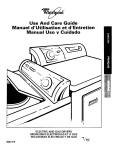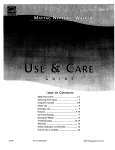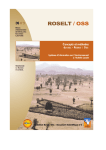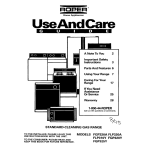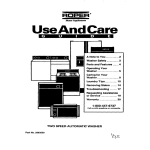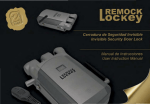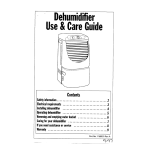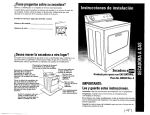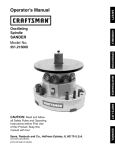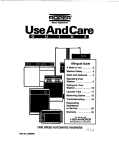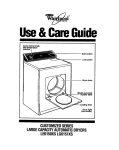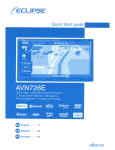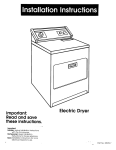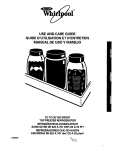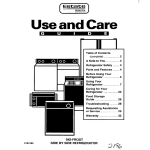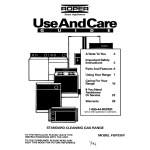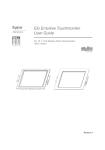Download Whirlpool 340 1094 Clothes Dryer User Manual
Transcript
UseAndCare r Table of Contents . . . . .. . . . . 2 A Note to You .,............... 2 Dryer Safety . . . . . .. . . . . . . . . . 3-4 Parts and Features Operating Laundry ....... . 5 Your Dryer . . . . 6 Tips . . . . . .. . . . . . . . . . 13 Caring for Your Dryer . . . . .. . . . . .. . . .. . . . . 17 Troubleshooting . . . . .. . . . . 22 Requesting Assistance or Service in U.S.A. .. . . . 24 Warranty t 1-800-253-l 301 Call our Consumer Assistance Center with questions or comments from anywhere in the U.S.A. ELECTRIC AND GAS DRYERS 340 1094 . . . . . . . . . . .. . .. . . . . .. . . 26 A Note to You.. .......................................... Dryer Safety ........................................... 2 3-4 Choosing load sizes ............................ 13 Drying tips ........................................... 13 5 Using dryer fabric softeners ................ 14 .............................. 6 Starting your dryer ................................ 6 items.. .................. 15 Caring for Your Dryer ............................. 17 Every load cleaning ............................. 17 Parts and Features Operating ................................... your Dryer Stopping/restarting your dryer.. ............. 6 Drying special-care Selecting a cycle and setting.. ............... 6 As needed cleaning ............................ 18 End of cycle signal .............................. Changing the drum light ...................... 21 Vacation care. ..................................... 21 Saving energy ..................................... 21 11 Using End of cycle signal and FINISH GUARD@ feature.. ................... 11 Using the drying rack .......................... 12 Troubleshooting ..................................... 22 Lint signal.. .......................................... 12 Tips ........................................... 13 Requesting Assistance or Service in U.S.A ................................. 24 13 Warranty .................................................. 26 Laundry Sorting clothes .................................... A Note to You Thank you for buying a WHIRLPOOL@ appliance. Because your life is getting busier and more complicated, WHIRLPOOL dryers are easy to use, save time, and help you manage your home better. To ensure that you enjoy years of trouble-free operation, we developed this Use and Care Guide. It contains valuable information about how to operate and maintain your dryer properly and safely. Please read it carefully. Also, please complete and mail in the Ownership Registration Card provided with your appliance. The card helps us notify you about any new information on your appliance. Please record your model’s information. Whenever YOU call to request service on your appliance, you need to know your complete model number and serial number. You can find this information on the model and serial number label in the door well (see diagram on page 5 for location of label). Please also record the purchase date of your appliance and your dealer’s name, address, and telephone number. Keep this book I and the sales slip together Model Number Serial Number Purchase Dealer Name Dealer Address Dealer Phone in a safe place Our Consumer Assistance Center number is toll-free 24 hours a day from anywhere in the U.S.A. 2 Date for future 1-800-253-1301 reference. Dryer Safety Your safety is important to us. This guide contains safety statements under warning symbols. Please pay special attention to these symbols and follow any instructions given. Here is a brief explanation of the use of the symbol. IMPORTANT SAFETY This symbol -lr-l -vi11 will help alert you to such dangers as fire, electrical shock, rsonal injury. burns, and personal I INSTRUCTIONS - Do not store or use gasoline or other flammable in the vicinity of this or any other appliance. vapors and liquids - WHAT TO DO IF YOU SMELL GAS: Do not try to light any appliance. l Do not touch any electrical switch; do not use any phone in your building. l Clear the room, building, or area of all occupants. l Immediately call your gas supplier from a neighbor’s phone. Follow the gas supplier’s instructions. l If you cannot reach your gas supplier, call the fire department. Installation and service must be performed by a qualified installer, service agency, or the gas supplier. l continued on next page 3 IMPORTANT SAFETY INSTRUCTIONS Read all instructions before using your dryer. l Dryer must be electrically grounded. See the Installation Instructions. l Do not machine wash or machine dry items cleaned, washed, soaked in, or spotted with wax, paint, gasoline, oil, dry cleaning solvents, or other flammable fluids. The fumes can create a fire hazard or explosion. Always hand wash and line dry items containing these materials. l Do not wash or dry items that are soiled with vegetable or cooking oil. These items may contain some oil after laundering. Due to the remaining oil, the fabric may smoke or catch fire by itself. * Store flammable solvents or fluids away from your dryer. l Dry cleaning solvents or fluids should never be put directly into your dryer. l Do not let dust, lint, paper, rags, chemicals, etc., pile up around or under the dryer. l l l l l l l l l l l Do not allow children to operate, play with, or crawl inside your dryer. Supervise children when they are near your dryer. Do not reach into a dryer if the drum is moving. Install and/or store dryer where it will not be exposed to the weather. Do not tamper with the controls. Do not dry rubber, rubber-like, or heatsensitive materials with heat. Unplug the power supply cord or turn off electrical power before attempting to service your dryer. Also, shut off gas valve if you have a gas dryer. When removing from service or discarding a dryer, always remove the door to prevent accidental entrapment. Clean lint screen before or after each load. Use only fabric softeners specifically labeled as not being harmful to the dryer. Do not allow lint to build up inside the dryer or exhaust system. Cleaning should be done periodically by a qualified person. - SAVE THESE INSTRUCTIONS Understanding l 4 your - responsibilties Be sure that your dryer: -is located in an area where the temperature is above 45°F (7°C). -is properly installed in a well-ventilated room and leveled on a floor that can support the weight.* -is connected to the proper outlet and electrical supply.* -is properly connected to fuel and exhaust systems (gas dryers must be vented outdoors).* -is not installed against draperies or curtains, or on carpet.* -is properly maintained, repaired, and has parts replaced by a qualified person. l -is used only for jobs normally expected of home clothes dryers. -is not used by anyone unable to operate it properly. Never operate the dryer if: - it is damaged. - parts are missing. - all panels are not in place. -the lint screen is loose, damaged, or missing. * See the Installation plete information. Instructions for com- Parts and Features The parts and features of your dryer are illustrated below. Become familiar with all parts and features before using your dryer. Page references are included next to some features. Refer to those pages for more information about the features. NOTE: The drawings in this book may vary from your dryer model. They are designed to show the different features of all models covered by this book. Your model may not include all features. Temperature selector* Cycle control knob y (may include temperature settings’) (PP. 6-g) Start button (P. 6) \ Consumer Assistance Cente;;;zb; (l-800-2534.3&j Model and serial number label (P. 2) \ Lint screen (P. 17) Wide-opening door* Dryer drum (P. 18) Other doors: Full-width Mini-hamper Side-swing Other hamper door* features not shown: End of cycle signal selector* FINISH GUARD* feature selector* Drying rack* Lint signal* Drum light’ (p. 11) (p. 11) (p. 12) (p. 12) (p. 21) door’ door* l On some models 5 Operating Your Dryer The information in this section helps you learn to use your dryer efficiently and safely. Refer to “Laundry Tips” on page 13 for additional information on sorting, loading, and drying most types of washables. NOTE: Before using your dryer, wipe the dryer drum with a damp cloth to remove dust from storing and shipping. Starting your dryer 1. Load clothes into the dryer and close the door. 3. If your dryer has a Temperature Selector, set It to the desired setting (see page 9). Some dryer models have either a rotary knob or pushbutton Temperature Selector. 2. Turn the Cycle Control Knob to the desired cycle and setting. Use the Energy Preferred Automatic Setting b) to dry most loads. (See pages 7 -I and 8 for cycle descriptions.) la 4. Push the Start Button. NOTE: Your dryer stops automatically when a cycle ends. Stopping/restarting your You can stop your dryer anytime during a cycle. To stop the dryer, either: l Open the dryer door. dryer To restart the dryer: 1. Close the door. 2. Select a new cycle and temperature (if desired). 3. Push the Start Button. OR Turn the Cycle Control Knob to Off. NOTE: The Cycle Control Knob should point to an Off area when the dryer is not in use. l Selecting a cycle and setting The following pages describe the cycles on your dryer. Refer to the charts on pages 9-10 for help in selecting drying cycles. 6 Drying l l l l guidelines Always follow care label directions when they are available. Use the Fluff Air cycle, or line dry rubber, plastic, delicate, and heat-sensitive fabrics (see page 10). The last few minutes of all cycles are without heat to make the load easier to handle. To help reduce wrinkling, remove the load from the dryer as soon as tumbling stops. This is especially important for permanent press, knits, and synthetic fabrics. Cycle l Overdrying can cause shrinkage, static cling, and damage to some fabrics. Refer to pages 13-l 6 for information about: - sorting clothes for drying - choosing load sizes -drying tips - using dryer fabric softeners - saving energy - drying special-care items. descriptions Automatic cycle(s) Dry most loads uslng the Energy Preferred Automatic Settlng (t). Your Automatic cycle(s) shuts off when the selected dryness is reached. The Cycle Control Knob will not move until the load is almost dry. After the cool-down, the knob automatically turns to an Off area and tumbling stops. If the load is drier than you like, select a setting closer to Less Dry the next time you dry a similar load. . If the load is not as dry as you like, complete drying using a Timed cycle. Select a setting closer to Very Dry the next time you dry a similar load. Some models offer high heat and low heat Automatic cycles (see page 9). NOTES: l Some Automatic cycles use an electronic Dry-Miser@ control that senses the amount of moisture in the load. l Other Automatic cycles use an automatic Dry-Miser control that senses the exhaust temperature and determines the dryness of the load. l l Timed cycle(s) Use a Timed cycle to complete drying if some items are damp after Automatic drying. Timed drying is also useful for: l Delicate items and small loads that need a short drying time. l Bulky items and large loads that require a long drying time. Some models offer high heat and low heat Timed cycles (see page 9). Fluff Air cycle (on some models) The Fluff Air cycle has no heat. Use this unheated cycle to fluff or air dry bedding, plastic tablecloths, foam pillows, sneakers, etc. See page 10 for more information about the Fluff Air cycle. NOTE: If your model does not have the Fluff Air cycle, line dry heat-sensitive items. 7 Heavy Dry cycle FINISH models) (on some (on some Use Heavy Dry and a high heat setting to - dry large items or items that are thicker or heavier than a regular load (such as heavy cotton bath sheets or robes). Damp Dry cycle (on some models) Use Damp Dry to dry items to damp level or to dry items that do not require an entire drying cycle. Two examples are heavy cottons, such as jeans, which you do not want to become stiff, or cotton clothes which are easier to press when I damp. TUMBLE (on some PRESS@ cycle models) The TUMBLE PRESS cycle removes wrinkles from clothes that have been packed in a suitcase or closet, or from items not removed from the dryer at the end of a cycle. As soon as the dryer stops, fold or put the items on hangers. J Towels feature (on some models) When you have large loads of towels to dry, you may want to use the Towels feature in the Automatic cycle. The Towels setting allows for more drying time and automatically shuts off the dryer when the selected dryness is reached. The Towels feature also can be used for extra heavy items such as mattress pads and quilts. 8 GUARD@ feature models) When you are unable to remove a load from the dryer as soon as it I stops, wrinkles can form. The FINISH GUARD feature tumbles the load without heat every few minutes up to 45 minutes after the cycle ends. This tumbling rearranges and fluffs the load to avoid wrinkles. You do not have to set the Cycle Control Knob for the FINISH GUARD feature. If you do not open the dryer door within a few minutes after the cycle stops, the FINISH GUARD feature takes over to protect the load. A signal sounds every few minutes when FINISH GUARD is running. The signal and cycle stop when you open the dryer door. NOTE: See page 11 if your model has a FINISH GUARD On/Off selector. Rack Dry feature (on some models) You may want to dry some items without tumbling (such as wool sweaters, stuffed toys, or pillows). Use the drying rack (see page 12) and the Rack Dry feature for these items, and a low temperature setting. During the drying cycle, the drum turns, but the rack does not move. Drying time depends on the amount of moisture in the items. NOTES: l Be sure to follow the instructions on page 12 for installing the drying rack in your dryer and placing items on the rack. l Use the chart on page 12 to determine temperatures and drying times. l You may use either the Timed cycle or Fluff Air cycle for rack drying. Drying cycles chart Use the chart below to help you make drying selections. The chart suggests heat settings and drying times for various loads. NOTES: l Use an Automatic cycle to dry most loads. l Use a Timed cycle only if the recommended Automatic cycle is not available. l l The check mark (J) in the chart below denotes recommended temperature settings. If some types of loads in the chart have more than one suggested temperature setting, choose the lowest setting available on your dryer. Always follow care label directions when they are available. High COTTONS AND LINENS Extra Heavy Bedspreads, mattress pads, quilts Heavywelght Towels, jeans, corduroys, work clothes Mediumwelght Sheets, cotton underwear, diapers Lightweight Batistes, organdies, lingerie PERMANENT PRESS, SYNTHETICS, AND BLENDS Heavyweight Work clothes, jackets, raincoats Mediumweight Shirts, play clothes, sheets, slacks Lightweight Lingerie, blouses, dresses KNITS Heavyweight Cottons, rayons, blends, T-shirts, slacks, shirts Mediumwelght Synthetics (polyester, acrylic, etc.), dress slacks, skirts, sweaters Lightweight Synthetics (polyester, acrylic, etc.) and blends, lingerie, blouses, dresses DELICATES” Sheer curtains (2 or 3 panels), gauze, lace, etc. TIMED CYCLE (minutes) AUTOMATIC CYCLE (heat settings) TYPE OF LOAD Medium* Low Fi$ High J 70-80 J 50-60 J J 40-50 J 20-30 J J Low 40-50 J 30-40 J 20-30 J 40-50 J 30-40 J J 20-30 J J 15-20 l Settings available only on dryer models with separate Temperature Selector. ** Fluff Air cycle (if available) or line drying is also recommended for delicate fabrics. (See page 10.) Fluff Air cycle or line drying The chart below includes examples of items that require drying without heat. Use the Fluff Air cycle (if available on your dryer model), or place the items on a line or rack to air dry. NOTES: Heat-sensitive fabrics should not be dried in the dryer. l Line dry bonded or laminated fabrics. l Always follow care label directions when they are available. l Fire Hazard Use Fluff Air Cycle to dry items listed below. Do not use heat to dry these items. Failure to do so can result in death or fire. FLUFF AIR CYCLE* (minutes) TYPE OF LOAD DELICATE FABRICS Sheer curtains (2 or 3 panels), gauze, lace, etc. (Use Fluff Air cycle if low heat is not available. See page 9.) RUBBER, PLASTIC, HEAT-SENSITIVE FABRICS Foam Rubber - Pillows, padded bras, stuffed toys l Make sure coverings are securely stitched. l Shake and fluff pillows by hand several times during the Fluff Air cycle. l Make sure pillows are completely dry. Foam rubber pillows take a long time to dry. Plastic - Shower curtains, tablecloths Rubber-backed rugs Olefin, Polypropylene, Sheer nylon COlTON AND CANVAS SHOES l Place several bath towels in the dryer to act as a buffer, or place shoes on a drying rack if your dryer has one. l Remove shoes from dryer while still damp. l Stretch shoes and allow to air dry. * Reset cycle as needed lo complele 10 drying. 20-30 20-30 20-30 40-50 1O-20 30-40 End of cycle (on some signal models) The dryer sounds a signal to let you know when the cycle is finished. The signal is helpful when you are drying permanent press, synthetics, and other items that should be removed from the dryer as soon as it stops. l l Using End of cycle signal FINISH GUARD@ feature (on some On some dryers, the end of cycle signal is not adjustable. On other dryers, the end of cycle signal can be turned On or Off by a selector. The end of cycle On/Off selector is part of the Start Button on some models. The various types of selectors are described in the chart below. and models) If your dryer has the end of cycle signal and/or FINISH GUARD feature, they may be turned On or Off as shown below. NOTE: Unless you turn Off the FINISH GUARD feature, it operates at the end of the cycle. SElTiNG T SEPARATE KNOBS Your model may have one of the following: Separate knob selectors for end of cycle signal and FINISH GUARD feature. l CLEAN TOUCHm pushbutton pad for both features. l OR CLEAN TOUCH SELECTOR End of Cycle Signal OFF Finish Guard OFF End of Cycle Signal OFF Finish Guard ON End of Cycle Signal ON Finish Guard OFF End of Cycle Signal ON Finish Guard ON 11 Using the drying (on some models) rack The drying rack lets you dry items that you may not want to tumble. The rack does not move, but the drum turns. 1. Fit rear legs of the rack into indentations -in the back wall of the dryer. Lower the front so the legs rest on the dryer opening. 4. Select the Timed drying cycle (and temperature, if needed) or the Fluff Air cycle (see page 7). 5. Push the Start Button. 2. Put wet items on top of the rack. Leave space between the items so air can reach all surfaces. NOTE: Make sure nothing hangs over the edge of the rack. NOTES: l See the chart below for suggested cycles and settings for the different types of items that might best be rack dried. . The rack must be removed for normal tumbling. l Drying time will depend on how much moisture the items hold. The following chart suggests drying times. 3. Close the door. q 11 I CYCLE TEMPERATURE I TIME* I (minutes) Timed LOW or EX LOW 60 Stuffed toys or pillows (Cotton or polyester fiber filled) Timed LOW or EX LOW 60 Stuffed toys or piiiows (Foam rubber filled) Sneakers or canvas shoes Fluff Air None; cycle is unheated. 90 (Block to shape and lav flat on the rack) 30-40 ’ Reset cycle as needed to complete drying. Lint signal (on some models) The lint signal (a whistle tone) indicates excessive lint is present on your lint screen. A full lint screen restricts airflow and reduces drying efficiency. When you hear the signal, stop the dryer and clean the lint screen. 12 NOTE: Clean your lint screen before each load. Do not wait for the lint signal. Laundry Tips This section provides information on preparing clothes for drying, drying guidelines, instructions for drying special-care items. NOTES: Refer to your Washer Use and Care Guide for proper washing techniques laundry tips. l See pages 3 and 4 of this book for Important Safety Information. l Sorting and additional clothes Separate dark from light colors; colorfast from non-colorfast. Items properly sorted for washing are usually properly sorted for drying. l and l Separate lint givers (towels, chenille) from lint takers (corduroy, synthetics, permanent press). When possible, turn lint takers inside out. eavy fabrics (denim, towels) from light fabrics (synthetics, permanent press). Choosing l ems with smaller items. Load the dryer by the amount of space items take up, not by their weight. Do not overload the dryer. Overcrowding causes uneven drying and wrinkling, and can cause items to wear out faster (because of pilling). You may need to rearrange large items (sheets, blankets, tablecloths) during a cycle to reduce balling or rolling up. Drying l l load sizes l For better tumbling action, when drying only a few small items, add one or two lint-free towels. This also prevents small, lightweight items from blocking airflow. tips Close zippers, snaps, and hooks to avoid snagging other items. Remove heat-sensitive trim that can be damaged by drying. Tie strings and sashes so they will not tangle. Check garments to make sure all spots and stains were removed during the wash. Do not tumble dry soiled or stained items. Heat may permanently set stains. l l l Sharp or metal objects can damage your dryer. Check pockets for pins, clips, money, bolts, nuts, etc. Do not lay these objects on your dryer after emptying pockets. Turn pockets of heavy items inside out for even drying. Place small items such as baby socks or hankies in a mesh bag for easier removal. Articles to be ironed should be removed from the dryer while still damp. 13 Using dryer fabric softeners Dryer fabric softeners are recommended for reducing static cling and for softening fabrics. Always follow package instructions carefully. l Put one fabric softener sheet on top of the load before starting the dryer. Do not add a fabric softener sheet after the drying cycle has started. Instant heat can cause the fabric softener to spot fabrics. l Remove fabric softener stains by wetting the stains and rubbing them with liquid detergent or bar soap and rewash. l Some fabric softeners may cause a buildup on the lint screen. See “As needed cleaning” on page 18. 14 Drying special-care items Most garments and household textiles have manufacturer’s care labels with laundering instructions. Always follow care label directions when they are available. Pages 9 and 10 include drying instructions for most types of washables. The chart below provides drying instructions for special-care washables. ITEMS DRYING INSTRUCTIONS Blankets woolens l l and Cotton, rayon, synthetic blankets Electric blankets, electric sheets, woolen blankets, washable woolen garments Curtains, slipcovers l Draperies, slipcovers Diapers, clothes Elastic baby items Flame-retardant finishes Machine drying knitted woolens is not recommended. Block to shape when wet and allow to air dry. Line dry blankets in the shade on a breezy day over two lines. Pin edges together and straighten them. When partly dry, turn the blanket over, repin, and restraighten. When dry, brush nap. Dry as recommended for permanent press fabrics on page 9. if manufacturer recommends machine drying: 1. Place one or two dry towels in the dryer and preheat 3-5 minutes on a high setting. This will dry blankets faster and help avoid pilling. 2. Put blanket in dryer with warm towels. Set control for 20 minutes. 3. Check after 10 minutes. Remove when still damp. Overdrying and long tumbling can cause shrinking and pilling. 4. Place blanket on flat surface, or over two lines to finish drying. Gently stretch to original size and shape. 5. When completely dry, brush gently to raise nap. Press binding with cool iron if needed. Remove drapery weights and hooks before laundering. For slipcovers, replace while still slightly damp. They will dry to fit tightly. Dry only a few minutes. 1. Leave room in dryer for load to fluff. 2. Remove from dryer while slightly damp. Do not overdry. Wash and dry small items in a mesh bag or pillowcase for convenient handling. Remove diapers and cotton knit items while still slightly damp. They will feel softer, shrink less, and be easier to fold. Remove from dryer while still slightly damp. Some items have been treated with a flame-retardant finish to improve their resistance to burning. Such items are clearly labeled. To retain flame-retardant qualities through continuous use and washing, clean and dry according to the manufacturer’s instructions. continued on next page 15 ITEMS DRYING INSTRUCTIONS Napped items Dry separately or with similar colors to avoid lint transfer. Follow care label instructions. 1. Remove from dryer while there is still a trace of moisture. 2. Smooth, reshape, and air dry before putting away. l Corduroy, velveteen Quilted, downfilled items Follow care label instructions. 1. Dry one at a time. 2. Remove from dryer and shake or fluff the item during the drying cycle. 3. Smooth and reshape before putting away. Snowsuits, jackets Check label for fiber content, then follow care label instructions. l Nylon or polyester 1. Dry garment for about 10 minutes. Remove and turn inside out. Dry for 10 more minutes. 2. Remove from dryer immediately and hang on a non-rusting hanger to finish drying. This will help eliminate wrinkles. Tinted, dyed, or noncolorfast items Dry according to fabric, weight, and care label instructions. Wipe the dryer drum carefully to remove any dye or lint that can be transferred to other loads. See “As needed cleaning” on page 18. Washable Do not overdry knits. Overdrying can cause shrinking and static cling. 1. Select cycle according to fabric and construction. 2. Turn synthetics and blends inside out when drying to avoid pilling. 3. Remove cotton and rayon knits while still slightly damp. Stretch into shape and lay flat to finish drying. 16 knits Caring for Your Dryer Proper care of your dryer can extend its fife. This section explains how to care for your dryer properly and safely. Every load cleaning Cleaning the lint screen The lint screen is located under a lid on top of the dryer. Clean it before each load. A screen blocked by lint can increase drying time. 1. Open the lid and pull the lint screen towards you. IMPORTANT: Do not run the dryer with the lint screen loose, damaged, blocked, or missing. Doing so can cause overheating and damage to both the dryer and fabrics. l Some towels made of synthetic fibers and natural fibers (polyester and cotton blends) may shed more lint than other towels, causing your dryer’s lint screen to fill up faster. Be sure to remove lint from the lint screen before and after drying new towels. l 2. Roll lint off the screen with your fingers. Do not rinse or wash screen to remove lint. Wet lint is hard to remove. 3. Push the lint screen firmly back into place and close the lid. 17 As needed cleaning Exterior Clogged Wipe with a soft, damp cloth. Laundry detergents and fabric softeners can cause a residue buildup on the lint screen. Clean the lint screen with a nylon brush every 6 months or more frequently if it becomes clogged due to a residue buildup. Use the following method: 1. Wet both sides of lint screen with hot water. 2. Wet a nylon brush with hot water and liquid detergent; scrub lint screen with the brush to remove residue buildup. Interior Explosion Hazard Use nonflammable cleaner. Failure to do so can result in death, explosion, or fire. Garments which contain unstable dyes, such as denim blue jeans or brightly colored cotton items, may discolor the dryer interior. To clean dryer drum: 1. Unplug the power supply cord. 2. Make a paste with powdered laundry detergent and very warm water. 3. Apply paste to a soft cloth OR Apply a liquid, nonflammable household cleaner to the stained area and rub with a cloth until all excess dye is removed. kz!l 4. Wipe drum thoroughly with a damp cloth. 5. Tumble a load of rags to dry. 6. Reconnect power. 18 lint screen 3. Rinse screen with hot water. 4. Thoroughly dry lint screen with a clean towel; replace in dryer. Removing accumulated lint Lint can gather inside the dryer and be a fuel for fire. Lint should be removed every 2 to 3 years, or more often, depending on dryer usage. Cleaning should be done by a qualified person. If you have any questions or comments, please call our Consumer Assistance Center at l-800-253-1 301 from anywhere in the U.S.A. Electrical Shock Hazard Unplug dryer before removing dryer panels. Wear gloves when handling dryer parts. Make sure door switch wires are not touching the dryer drum before closing the top. See page 20, Step 7. Failure to do so can result in death, electrical shock, or serious cuts. For ail electric dryers, or gas dryers which have a lower front access panel NOTE: See page 20 if your dryer is gas and has a full front panel. 1. Unplug the power supply cord or turn off the electrical power. 2. Remove back panel using a hex-head screwdriver (l/4 inch). 3. Remove lint from shaded area in illustration with a soft brush or vacuum cleaner. Avoid damaging wires, thermostats (electric), funnel (gas), or ignitor (gas). 4. Replace panel; Reconnect and level dryer again, if necessary. Thermostats Electric Heater box Heat element terminals dryer with back panel removed ignitor \ il Fuynel Gas dryer with lower front access panel removed 19 If your dryer is gas and has a full front panel, remove front panel as follows: 1. Unplug the power supply cord or turn off the electrical power. 2. Open lint screen lid. Remove two screws from lint screen area. 3. Open top by pulling forward and up at each front corner (see View A). Rest raised top against wall behind dryer (top is hinged at rear). 4. Remove two internal screws from front panel flanges (near top front corners). Lift front panel slightly, lifting off lower clips (see lower clip inset of View B). Slowly pull front panel forward, disengaging panel from drum. (Drum will drop slightly.) 5. Move front panel aside and rest edge against side of dryer. Avoid disconnecting wire clips (see wire clips inset of View B) or damaging wires. 6. Remove lint from area shown in “gas dryer” illustration on page 19 with soft brush or vacuum cleaner. Avoid damaging wires, funnel, or ignitor. 7. Reassemble in reverse order. Before closing the top, check the following: -Drum seal must be flared out (see drum seal insets of View B) and properly positioned against panel at back of drum. Rotate drum counterclockwise one full turn to check drum seal. -Belt should be centered and tight on dryer drum. -Wire clips which hold the door switch wires must be anchored in slot in top of front panel (see wire clips inset of View B) and along top edge of side panel. Door wires must not touch drum when dryer is operating. 8. Replace top panel and lint screen screws. Top and front panels must be securely in place before operating dryer. 9. Reconnect power and level dryer again (if necessary). 20 Remove screws before opening top 64 View A View B Changing (on some the drum light models) The dryer light automatically turns on inside the dryer drum when you open the door. Fire Hazard Unplug dryer before changing light bulb. Replace light bulb cover before operating dryer. Failure to do so can result in death, fire, or electrical shock. 2. Open the dryer door. Remove the light bulb cover from the back wall of the dryer by turning the cover clockwise. 3. Remove the light bulb counterclockwise. 4. Replace the bulb with bulb only. he light bulb in place by clockwise. by turning it a 40-watt appliance cover and lock turning counter- 6. Reconnect power supply. To change drum light: 1. Unplug the dryer or disconnect the electricity leading to the dryer at the main power supply. Vacation care 1. Unplug power supply cord or turn off electrical power supply. 2. Clean lint screen. Saving l l l l energy Use an Automatic cycle to dry most loads. Dry only full loads without overdrying. Avoid overloading dryer, adding wet items to a partly dried load, or opening the door unnecessarily. Plan your laundry to dry one load after another. A warm dryer shortens drying time. l Shorten drying times by exhausting dryer properly and cleaning exhaust duct and outside exhaust hood as needed. - Keep the lint screen clean. - Use your dryer in a room where room air temperature is above 45°F (7°C). - Sort loads by fabric weight and type. 21 Troubleshooting Most laundering problems are easily solved if you understand the cause. Check the following list for laundry problems you may have and their possible causes. Also refer to the next page for a dryer checklist which can help you solve some simple problems without calling for service. If you still need help, see “Requesting Assistance or Service in U.S.A.” on page 24. Common laundry problems PROBLEM CAUSE Greasy spots l Dryer fabric softener improperly used. See manufacturer’s l Drying soiled items. l Full lint screen. (See page 17.) l Load not properly sorted. Lint Overdrying, especially static electricity. l Shrinking Slow drying Stains Static electricity synthetic fabrics that cause lint-attracting l Load size too big or heavy. l Tissue or paper left in pockets. l directions. Pilling (surface fuzz caused by normal wear and laundering) attracts lint. l Overdrying. l Fabric type and quality inappropriate l Dryer settings incorrect for fabric type. l Manufacturer’s l Full lint screen. l Load too large and bulky to dry quickly. l Dryer located in room with temperature below 45°F (7°C). l Exhaust duct clogged, restricted, or too long. l Drying soiled items. l Dryer fabric softener improperly used. See manufacturer’s l Dryer interior stained. (See page 18 for cleaning procedures.) l Overdrying. l Dryer fabric softener improperly used. See manufacturer’s care label instructions for drying. not followed. directions. directions. . Load includes synthetics, synthetic blends, permanent press, and knit fabrics that build up static electricity. Wrinkling 22 l Overloading. l Overdrying, l Clothes left in dryer at end of cycle. especially permanent press, and synthetic fabrics. Common dryer problems Before calling for service, check these: Is the dryer door firmly closed? ‘0 0 liicl Are the controls set in an ON position? q Did you firmly push the Start Button? Is lint screen clogged with lint? El!! Is the power cord plugged in? Have you blown a fuse or tripped the circuit breaker? Is exhaust duct or outside exhaust hood clogged with lint? For gas dryers, are the valves open on the dryer and the supply line? Is the dryer making noise? Is there a thumping sound from support rollers indicating dryer has not been used for awhile? Is the lint signal sounding? If you still have problems, see “Requesting Assistance or Service in U.S.A.” on page 24. 23 Reauestina Assistance Se&ice inTJ.S.AI or Before calling for assistance or service, please check “Troubleshooting” on pages 22-23. It may save you the cost of a service call. If you still need help, follow the instructions below. 1. If you need assistance* ... Call the Whirlpool Consumer Assistance Center telephone number. Dial toil-free from anywhere in the U.S.A.: w 1-800-253-l 301 Ea and talk with one of our trained consultants. The consultant can instruct you in how to obtain satisfactory operation from your appliance or, if service is necessary, recommend a qualified service company in your area. If you prefer, write to: Mr. William Clark Consumer Assistance Representative Whirlpool Corporation 2000 North M-63 Benton Harbor, Ml 49022-2692 Please include a daytime phone number in your correspondence. 2. If you need service* -See: Whirlpool Appliances or Aulhorized Whirlpool Service (Example: XYZ Selvlce Co.) l WASHING DRYERS, FSP* parts ... FSP is a registered trademark of Whirlpool Corporation for quality parts. Look for this symbol of quality whenever you need a replacement part for your WHIRLPOOL* appliance. FSP replacement parts will fit right and work right, because they are made to the same exacting specifications used to build every new WHIRLPOOL appliance. To locate FSP replacement parts in your area, refer to Step 2 or call the Whirlpool Consumer Assistance Center number in Step 1. 4. If you are not satisfied with how the problem was solved . . . l ... Whirlpool has a nationwide network of authorized Whirlpool service companies. Whirlpool service SERVICE technicians are trained to fulfill the product warranty and FEil provide after-warranty service, anywhere in the United States. To locate the authorized Whirlpool service company in your area, call our Consumer Assistance Center telephone number (see Step 1) or look in your telephone directory Yellow Pages under: -APPLIANCE-HOUSEHOLD MAJOR, SERVICE 8 REPAIR 3. If you need replacement l l Contact the Major Appliance Consumer Action Program (MACAP). MACAP is a group of independent consumer experts that voices consumer views at the highest levels of the major appliance industry. Contact MACAP only when the dealer, authorized servicer, and Whirlpool have failed to resolve your problem. Major Appliance Consumer Action Program 20 North Wacker Drive Chicago, IL 60606 MACAP will in turn inform us of your action. MACHINES & SERVICE & REPAIR -See: Whirlpool Appliances or Authorized Whirlpool Service (Example XYZ Service Co.) When asking for help or service: Please provide a detailed description of the problem, your appliance’s complete model and serial numbers, and the purchase date. (See page 2.) This information will help us respond properly to your request. l 24 WHIRLPOOL” Dryer Warranty Outside the United States, a different your authorized Whirlpool dealer. warranty may apply. For details, please contact 1 LENGTH OF WARRANTY 1 WHIRLPOOL WILL PAY FOR FSP@ replacement parts and repair labor to correct defects in materials or workmanship. Service must be provided by an authorized Whirlpool service company. FULL ONE-YEAR WARRANTY From Date of Purchase I WHIRLPOOL WILL NOT PAY FOR A. Service calls to: 1. Correct the installation of your dryer. 2. Instruct you how to use your dryer. 3. Replace house fuses or correct house wiring or plumbing. 4. Replace light bulbs. B. Repairs when your dryer is used in other than normal, single-family household use. C. Pickup and delivery. Your dryer is designed to be repaired in the home. D. Damage to your dryer caused by accident, misuse, fire, flood, acts of God, or use of products not approved by Whirlpool. E. Repairs to parts or systems caused by unauthorized modifications made to the appliance. 6-94 WHIRLPOOL CORPORATION SHALL NOT BE LIABLE FOR INCIDENTAL OR CONSEQUENTIAL DAMAGES. Some states do not allow the exclusion or limitation of incidental or consequential damages, so this exclusion or limitation may not apply to you. This warranty gives you specific legal rights, and you may also have other rights which vary from state to state. If you need service, first see the “Troubleshooting” section of this book. After checking “Troubleshooting” additional help can be found by checking the “Requesting Assistance or Service” section, or calling our Consumer Assistance Center telephone number, l-800-253-1301, from anywhere in the U.S.A. 3401094 0 1996 Whirlpool l/96 Corporalion e Rqslered TrademarkJTM Trademark 01 Whirlpool. USA Printed in U.S.A. Uso Y Cuidado lndice .. . . . . . . . .. . . . .. .. . . . .. .. . . . . . 2 Mensaje para el usuario . . . . .. . . . .. .. . . . .. . . . . . . .. . . 3 Seguridad Secadora de la . . .. . . . . . .. . . . .. . . 4 a 6 Partes y Caracteristicas .. . . .. . . . . . . . . . 7 C6mo Operar la Secadora . . . . .. . . . . .. . . . .. . .. . . . . 8 Consejos de Lavanderia . . . . .. . . . .. . . . . . . . . . 18 Cuidado de la Secadora . . . . .. . . . . . .. . . . . . . .. . 22 Localizando Averias .. . .27 Solicitando Asistencia o Servicio Tdcnico en E.U.A. .. . . . . . . . .. . . . .. . . . . . . . 30 Garantia .. . . .. . . . .. . .. . . . . . .. . . . 32 1-800-253-1301 I 3401094 Lidmenos con sus preguntas y comentarios de cuaiquier parte de 10s E.U.A. SECADORAS ELECTRICAS Y A GAS lndice Mensaje para ei usuario Seguridad de la Secadora Partes y Caracterfsticas 3 Consejos de secado . .. .. .. . .. .. . . .. .. . .. .. .. . . 18 ................. 4 a 6 Uso de suavizantes de telas para secadoras . .. .. .. . .. .. . .. .. .. . .. . .. . ... . . .. .. 19 ........................... ........................... 7 Cdmo Operar la Secadora ....................... 8 lniciar el funcionamiento ....................... 8 Coma detener o reiniciar el funcionamiento ...................................... Selection 8 de ciclos y tiempo ................. 9 Secado de articulos de cuidado especial .. .. .. . . .. .. . . .. .. . .. ... . .. .. . . .. .. .. . .. .. . .. .. 20 Cuidado de la Secadora .. .. . .. . .. .. . . .. ... . . ... . 22 Mantenimiento en cada carga . .. . .. . .. ... . .. .. .._................. 22 14 Mantenimiento segun sea necesario . . .. . .. . ... .. . .. .. . .. .. .. . . .. .. .. . ..._ 23 Uso de la seAal de fin de ciclo y de la funcion FINISH GUARD*. ........... 15 Cambio del foco del tambor . . .. .. . .. .. .. . .. 26 Sefial de fin de ciclo ............................ Uso de la parrilla de secado.. .............. 16 Serial de pelusa .................................. Consejos de Lavanderia Clasificacion 17 ........................ 18 de la ropa ....................... 18 Selection de tamaiio de carga .............................................. 18 Cuidado durante las vacaciones .. .. .. . .. 26 Ahorro de energia .. .. .. .. .. . .. . .. .. . .. .. .. . .. .. . 26 Locaiizando Averfas . .. .. .. .. . .. . .. .. .. .. ... . .. .. .. 27 Soiicitando Asistencia o Servicio Tknico en E.U.A. . .. .. .. ... .. . .. .. .. . 30 Garantia ................................................... 32 el usuario - ---a- Agradecemos la compra de un electrodomkstico WHIRLPOOL*. Porque su vida es cada vez mas activa y con mayores ocupaciones, las secadoras WHIRLPOOL son faciles de usar, ahorran tiempo, y le dan funcionalidad al hogar. Para asegurar que la secadora funcione por muchos adios sin problemas, hemos disenado este Manual de Uso y Cuidado. Contiene information valiosa acerca de coma operar y cuidar de su secadora correcta y seguramente. Por favor lealo con cuidado. Complete tambien y envie por correo la Tarjeta de Registro de Propietario que viene con su secadora. La tarjeta nos ayuda a notificarle toda information nueva sobre su secadora. Esto no aplica a 10s consumidores fuera de 10s E.U.A. Por favor anote la siguiente informacihn. Siempre que llame para solicitar servicio de la secadora, necesitara saber el modelo y numero de serie complete. Esta information se encuentra en la placa ubicada en el marco de la puerta (ver el diagrama de partes en la pagina 7). Por favor registre la fecha de compra de la secadora. asi mismo el nombre del distribuidor,‘direccion y telefono. Guarde este manual y la nota de compra referencia futura. Modelo Ntimero de serie Fecha de compra Nombre Direcckn Telkfono juntos, Las llamadas al niimero telefbnico de nuestro Centro de Atencibn al Cliente son gratis las 24 horas del dia de cualquier parte de 10s E.U.A. del distribuidor del distribuidor del distrlbuidor en un lugar seguro I-800-253-1 para 301 3 Seguridad Su seguridad para nosotros. de la Secadora es importante Este manual contiene avisos de seguridad con el simbolo de advertencia. Por favor d6 una atenci6n especial a estos simbolos y siga todas las instrucciones. Lo siguiente es una breve explicacih del uso del simbolo. INSTRUCCIONES SEGURIDAD Este simbolo le Ilamar la atenckn a ciertos tlpos de peligros tales coma incendlo, choque ektrico, quemaduras y lesiones personales. IMPORTANTES DE Lea la information que contiene este manual para reducir al minim0 el riesgo de incendio o explosion, o evitar daAos a la propiedad, lesiones personales o perdida de la vida. - No almacene ni use gasolina, o cualquier otro vapor o liquid0 inflamable cerca de la secadora o de cualquier otro aparato electrodomestico. - WE HACER SI HUELE A GAS: No intente encender ningun tipo de aparato electrodomestico. No toque ningun interruptor de electricidad; no use ningun telefono en su casa o edificio. l Desaloje la habitation, casa o edificio. l Llame inmediatamente a la compafiiia de gas del telefono de un vecino. Siga las instrucciones de la compafiia de gas. l Si no puede comunicarse con la compafiia de gas, llame a 10s bomberos. La instalacion y el servicio deben llevarse a cabo por un tecnico calificado, una agencia de servicio autorizada o la compafiia de gas. l l INSTRUCCIONES SEGURIDAD IMPORTANTES DE Para reducir el riesgo de incendio, choque elktrico o dafio a personas durante el uso de la secadora, siga las precauciones basicas que a continuaci6n se seiialan: Lea todas las instrucciones antes de usar la secadora. l La secadora debe estar conectada a tierra. @No lave ni seque a maquina prendas o articulos que hayan sido limpiados, lavados, empapados o manchados con cera, pintura, gasolina, aceite, solvente para limpieza en seco u otros liquidos inflamables. Los vapores pueden causal peligro de incendio o explosion. Los articulos que contengan estas substancias se deben lavar siempre a mano y secar en el tendedero. l No lave ni seque articulos que esten sucios con aceite vegetal o de cocina. Estos articulos, despues de lavarse pueden tener algun residuo de aceite. A causa de esto, la tela puede humear o incendiarse por si misma. l l l l l l l l l Guarde 10s solventes y liquidos l l l inflamables lejos de la secadora. Nunca introduzca solventes o liquidos para limpieza en seco en la secadora. No permita que polvo, pelusa, papel, panes, productos quimicos, etc., se acumulen alrededor o debajo de la secadora. No permita que la pelusa se acumule dentro de la secadora o del sistema de escape. La limpieza la debe realizar periodicamente un tecnico calificado. - GUARDE l l No permita que 10s nifios operen, jueguen o se introduzcan en la secadora. Vigile a 10s nines cuando esten cerca de la secadora. No introduzca manos ni brazos al tambor cuando este girando. lnstale y/o guarde la secadora en un lugar donde no este expuesta a la intemperie. No intente forzar ni reparar 10s controles por su cuenta. No seque lo siguiente con calor: caucho, materiales parecidos al caucho o materiales sensibles al calor. Desconecte el cable tomacorriente o el suministro de energia electrica antes de proporcionar servicio a la secadora. Cierre la valvula de gas si la secadora funciona a gas. Antes de deshacerse de una secadora que ya no funciona, retire la puerta para evitar que un nifio quede atrapado accidentalmente. Limpie el filtro de pelusa antes o despues de cada carga. Use suavizantes de telas que especifiquen en sus instrucciones que no daiian la secadora. ESTAS INSTRUCCIONES continlia en la siguiente p6gina 5 Es responsabilidad del usuario Asegurese de que la secadora: - este ubicada en un area donde la temperatura este sobre 10s 7°C (45°F). - este correctamente instalada en un ambiente bien ventilado, nivelada sobre un piso que resista su peso.+ - este conectada a una toma electrica adecuada.+ - este conectada correctamente al suministro de combustible y ventilation (las secadoras a gas deben tener una ventilation hacia el exterior).+ - no este instalada cerca de cortinas o sobre una alfombra.+ - se mantenga, repare y cambien piezas por tecnicos calificados. - se use solamente para 10s trabajos normales de una secadora domestica. - no sea usada por ninguna persona que no sepa operarla correctamente. l - GUARDE 6 Nunca haga funcionar la secadora si: - esta dafiada. - le faltan piezas. - todas 10s paneles no estan en su lugar. - el filtro de pelusa esta flojo, danado 0 falta. + Vea las lnstrucciones de Instalacion para information completa. l ESTAS INSTRUCCIONES - Partes y Caracteristicas A continuacih se detallan las partes y caracteristicas de la secadora. Familiaricese con ellas antes de usarla. Se incluyen 10s nfimeros de pigina junto a algunas de las caracteristicas. Refikase a esas paginas para mayor informacih. NOTA: Los dibujos de este manual pueden variar en relaci6n al modelo de su secadora. Han sido disehados para mostrar las diferentes caracteristicas de todos 10s modelos contenidos en el mismo. El modelo de su secadora quiz& no tenga todas las partes y caracteristicas que muestran 10s dibujos. Selector de Botdn de arranque (P&J 8) Placa de mod \ Filtro de pelusa (P&. 22) Puerta amplia con entrada extra grandet A \\ Otras puertas: Puerta a todo lo ancho del gabinetet Otros dispositivos que no se muestran: Selector de seiial de fin de ciclo+ Selector de funcibn FINISH GUARD*+ Parrilla de secadot SeAal de pelusa+ Luz del tambor+ (phg. 15) (phg. 15) (pig. 16) (phg. 17) (p&g. 26) Puerta horizontal pequeAa+ Puerta vertlcalt + En algunos modelos 7 C6mo Operar la Secadora La information de esta section le ensenara coma usar la secadora eficientemente y con seguridad. Para information adicional sobre la clasificacion, carga y secado de la mayoria de 10s tipos de prendas lea “Consejos de Lavanderia” en la pagina 18. NOTA: Antes de usar su secadora, limpie el tambor con un trapo humedo para quitar el polvo del almacenamiento o del transporte. lniciar 1. Coloque el funcionamiento la ropa en la secadora la puerta. y cierre 2. Gire la Perllla de Control de Ciclos al ciclo deseado. Para secar la mayoria de las cargas, utilice la Posicih Automtitlca de Energia Preferida (a). Vea las paginas 9 a 11 para mas information. C6mo detener o reiniciar 3. Si la secadora tiene un selector de temperatura, col6quelo en la temperatura deseada (ver phglna 12). Algunos modelos de secadora tienen una perilla glratorla 0 un selector de tecla. 4. Oprima el bot6n de arranque (Push to Start). NOTA: La secadora se detiene automaticamente cuando termina el ciclo. el funcionamiento Usted puede detener la secadora en cualquier moment0 durante un ciclo. Para detener la secadora: l Abra la puerta. l Gire la Perilla de Control de Ciclos a apagado (Off). NOTA: La Perilla de Control de Ciclos debe seAalar un area de apagado (Off) cuando la secadora no esta en uso. Para reiniciar el funcionamiento: 1. Cierre la puerta. 2. Seleccione un ciclo y temperatura (si se desea). 3. Oprima el baton de arranque. . h nuevos Seleccib de ciclos y tiempo Las siguientes paginas describen 10s ciclos de la secadora. Refierase a 10s cuadros de las paginas 12 a 14 para seleccionar el ciclo. Principios l l l l de secado Siempre siga las direcciones de 10s rotulos de cuidados cuando esten disponibles. Para secar tejidos delicados, cauchos, plasticos, y telas sensibles al calor, siempre use el ciclo Fluff Air (ciclo sin calor) 0 seque estos articulos en un tendedero (ver paginas 13 y 14). Los ultimos minutos de todos 10s ciclos se llevan a cabo sin calor para que sea mas facil de manejar la carga. Para reducir las arrugas, retire la carga de la secadora tan pronto se detenga el movimiento. Esto es especialmente importante para telas de planchado permanente, tejido de punto, y telas sinteticas. Descripcih Ciclos Secar la ropa en exceso puede causal encogimiento, estatica, y danos a algunas telas. . Refierase a las paginas 18 a 21 para information acerca de: - seleccionar ropa para secado - election de 10s tamanos de las cargas - consejos de secado - el uso de suavizantes de telas para secadora - ahorro de energia - secado de articulos de cuidado especial. l de ciclos autom6ticos Seque la mayoria de las cargas usando automAtica I I la poslclh de energia preferida (e). -. . El ciclo automatic0 se detiene cuando llega al secado elegido. La Perilla de Control de Ciclo no se movera hasta que la carga este casi seca. Despues del enfriamiento (Cool Down), la perilla automaticamente se corre al area de apagado (Off) y se detiene el movimiento. l Si la carga esta mas seca de lo deseado, la proxima vez que seque una carga similar seleccione una position m&i cercana a Menos Seca (Less Dry). l Si la carga no esta suficientemente seca, complete el secado usando un ciclo cronometrado (Timed cycle). La proxima vez que seque una carga similar seleccione una position mas cercana a Muy Seca (Very Dry). Algunos modelos ofrecen ciclos automaticos de calor alto y calor bajo (ver paginas 12 y 13). NOTAS: l Algunos ciclos automaticos usan el control electrhico Dry-Miser* que percibe la humedad en la carga. l Otros ciclos automaticos usan un control autom2itico Dry-Miser que percibe la temperatura de escape y determina la sequedad de la carga. continlia en la siguiente phgina 9 Ciclos cronometrados (Timed cycle) Ciclo de secado (Damp Dry) Use un ciclo cronometrado para completar el secado si algunas de las prendas estan htimedas despues del secado automatico. El secado cronometrado tambien es irtil para: l Articulos delicados y pequenas cargas que necesitan un tiempo corto de secado. l Articulos voluminosos y cargas grandes que necesitan un tiempo largo de secado. Algunos modelos ofrecen ciclos cronometrados de calor alto y bajo (ver paginas 12 y 13). (en algunos Ciclo El ciclo para desarrugar quita las arrugas de la ropa guardada en valijas o cajones, o de la ropa que no se retire de la secadora al concluir el ciclo. Tan pronto se detenga la secadora, doble 10s articulos o coloquelos en ganchos. cuando se abre la puerta de la secadora. sin calor (en algunos (Fluff Air) modelos) El ciclo sin calor no emplea calor. Use este ciclo sin calor para esponjar 0 secar con aire 10s siguientes articulos: ropa de cama, manteles de plastico, almohadas de espuma, zapatillas, etc. Ver las Advertencia y el cuadro en la paginas 13 y 14 para mas information acerca del ciclo Fluff Air. NOTA: Si su modelo no tiene ciclo Fluff Air, seque 10s articulos sensibles al calor en el tendedero. Ciclo pesado (Heavy Dry) (en algunos modelos) Use el ciclo pesado y la position de calor alta para secar articulos grandes o articulos que son mas gruesos 0 pesados que la carga normal (tales corn0 toallas de bafio o sabanas pesadas). 10 htimedo modelos) Use el ciclo de secado hOmedo para secar articulos que se desea quedar un poco hlimedos o para aquellos que no necesitan un ciclo complete de secado. DOS ejemplos son algodones pesados, tales coma mezclilla para que no queden duras o ropa de algodon que es m&s facil de planchar cuando este hOmeda. Ciclo para desarrugar (TUMBLE PRESS) (en algunos Funci6n (Towels (en algunos modelos) de Toallas feature) modelos) Para secar cargas grandes de toallas, use la funcion de toallas en el ciclo automatico. Esta funcion permite mas tiempo de secado y apaga la secadora automaticamente cuando llegue a la sequedad seleccionada. La funcion de toallas tambien se puede usar para articulos extra pesados coma forros de colchones o acolchados. Funcidn (en algunos FINISH GUARD* modelos) Si no se retira la carga en cuanto se detenga la secadora pueden formarse arrugas. La funcion FINISH GUARD mueve la carga sin el empleo de calor varias veces, durante 45 minutos despues de concluir el ciclo. Este movimiento reubica y esponja la carga para evitar arrugas. No hay que colocar la Perilla de Control de Ciclos en la funcion FINISH GUARD. Si no se abre la puerta en 10s siguientes minutos despues de concluir el ciclo, la funcion FINISH GUARD inicia automaticamente para proteger la carga. Cuando la funcion FINISH GUARD esta operand0 una seiial suena cada pocos minutos. La seAal y el ciclo se detienen cuando se abre le puerta de la secadora. NOTA: Ver en la pagina 15 si su modelo tiene un selector encendido/apagado (On/ Off) de FINISH GUARD. Secado (en algunos en la parrilla (Rack Dry) modelosl Si quiere secar sin movimiento articulos coma sueteres de lana, juguetes rellenos, 0 almohadas, use la parrilla de secado (ver pagina 16) y la funcion Rack Dry para estos at-ticulos. Tenga cuidado de usar una position baja de temperatura. Durante el ciclo de secado, el tambor gira, pero la parrilla no se mueve. El tiempo de secado depende de la cantidad de humedad que contengan las prendas. NOTAS: l l l Para instalar la parrilla en la secadora y colocar 10s articulos sobre ella lea las instrucciones de la pagina 16. Use el cuadro de la pagina 16 para determinar las temperaturas y tiempos de secado. Se puede usar el ciclo cronometrado o el ciclo Fluff Air para secado con parrilla. 11 Tabla de ciclos de secado Use el siguiente cuadro de guia al hater las selecciones de secado. El cuadro sugiere las temperaturas y tiempos de secado para las distintas cargas. l l NOTAS: l Use un ciclo automatic0 para secar la mayoria de las cargas. l TIP0 DE CARGA Use un ciclo cronometrado solamente si el modelo de secadora no tiene un ciclo automatico. La marca (/) en el cuadro indica la temperatura recomendada. Si para algunos de 10s tipos de cargas se sugiere mas de una temperatura, elija la mas baja disponible en el selector. Siempre siga las instrucciones de secado de las etiquetas que vienen en las prendas. Alto Medianot ALGODONES Y ROPA BLANCA Extra pesada Cubrecamas, forros de colchones, acolchados Pesada Toallas, mezclilla, pana, ropa de trabajo Medlana Sabanas, ropa interior de algodon, patiales Ligera Batas, organdi, ropa interior femenina PLANCHADO PERMANENTE, SINTETICOS Y COMBINACIONES Pesada Ropa de trabajo, chaquetas, impermeables Mediana Camisas, ropa de depone, sabanas, pantalones Ligera Ropa interior femenina, blusas, vestidos TEJIDOS Pesada Algodones, rayones, combinaciones, camisetas, pantalones y camisas Mediana Sinteticos (poliester, acrilico, etc.), pantalones de vestir, faldas, sueteres Ligera Sinteticos (poliester, acrilico, etc.) y combinaciones, ropa interior femenina, blusas, vestidos 12 CICLO CRONOMETRADO (minutos) CICLO AUTOMATIC0 (selection de temperatura) Bajo Extra bajot Alto J 70-80 J 50-60 J J 40-50 20-30 J J J Bajo 40-50 30-40 J J 20-30 J 40-50 J 30-40 J J 20-30 TIP0 DE CARGA Alto1 Medianot TELAS DELICADAW Cortinas delgadas (2 6 3 paneles), gasa, encajes, etc. + Selecciones disponibles ti Tambih se recomienda CICLO CRONOMETRADO (minutos) CICLO AUTOMATlCOt (Selection de temperatura) I roi I E?fi I solamente en IDS mcdelos con Selector de Temperatura. el ciclo de Secado sin calor (si esth disponible) o secado en el tendedero Secado sin calor en el tendedero (Fluff Air) Alto I 1 Ijo I para articulos delicados. o El cuadro en la siguiente pagina incluye ejemplos de articulos que necesitan secado sin calor. Use el ciclo Fluff Air (si esta disponible en su modelo de secadora), o coloque 10s articulos en tendedero o gancho para secar al aire. NOTAS: l No se deben secar telas sensibles al calor en la secadora. l Seque en tendedero las telas laminadas. l Siempre siga las instrucciones que vienen en las etiquetas de las prendas. Peligro de lncendio Use el ciclo de Secado sin calor para secar 10s articulos en la lista a continuacibn. No use calor para secar estos articulos. La falta de esta precaucih puede causar la muerte o un incendio. continlja en la siguiente pagina 13 CICLO FLUFF AlRt (minutos) TIP0 DE CARGA TEJIDOS DELICADOS Cortinas delgadas (2 6 3 paneles), gasa, encaje, etc. (Use el ciclo Fluff Air si no hay calor bajo disponible. Ver la pagina 13.) GOMA, PLASTICO, TELAS SENSIBLES AL CALOR Espuma de goma - almohadas, sostenes rellenos, juguetes rellenos l Asegurese que todos 10s forros esten bien cosidos. l Sacuda y esponje las almohadas a mano varias veces durante el ciclo Fluff Air. l Asegurese que las almohadas esten completamente secas. Almohadas de espuma de goma demoran mucho en secarse. Plastic0 - cortinas de ducha, manteles Alfombras con respaldo de goma Olefin, polipropileno, medias de nylon ZAPATOS DE ALGODON Y LONA l Coloque varias toallas de bario en la secadora de amortiguador, o coloque 10s zapatos sobre secado si su secadora la tiene. l Retire 10s zapatos de la secadora cuando sun l Estire 10s zapatos y permita que se sequen al + Vuelva a seleccionar Sefial el ciclo cuantas veces sea necesario 20-30 20-30 40-50 1O-20 30-40 esten humedos. aire. para completar el secado. de fin de ciclo (en algunos modelos) Cuando concluye el ciclo, la secadora emite una seiial audible. La sepal es de ayuda cuando se esten secando tejidos de planchado permanente, sinteticos y otros articulos que deben retirarse de la secadora tan pronto se detenga. 14 para actuar la parrilla de 20-30 l l En algunas secadoras la seAal de fin de ciclo no se puede programar. En otras secadoras, la senal de fin de ciclo se puede encender o apagar (On/Off) por medio de un selector (Cycle Signal). Este selector (On/Off) es parte del baton de arranque en algunos modelos. En el siguiente cuadro se describen 10s distintos tipos de selectores. Uso de la seiial de fin de ciclo funcih FINISH GUARD* (en algunos y de la modelos) Si la secadora tiene la seAal de fin de ciclo y/o la funcion de FINISH GUARD, se pueden encender y apagar segun se muestra mas adelante. NOTA: Si no se apaga la funcion FINISH GUARD, su funcionamiento inicia al final de cada ciclo. POSICION PERILLAS INDIVIDUALES La secadora puede tener cualquiera de 10s siguientes tipos de controles: l Perillas individuales para serial de fin de ciclo y funcion FINISH GUARD. l Controles de Toque Suave (CLEAN TOUCH*) para ambas funciones. 0 SELECTOR CLEAN TOUCH SeAal de fin de ciclo (End of Cycle Signal) Apagado Finish Guard Apagado Serial de fin de ciclo (End of Cycle Signal) Apagado Finish Guard Encendido SeAal de fin de ciclo (End of Cycle Signal) Encendido Finish Guard Apagado Seiial de fin de ciclo (End of Cycle Signal) Encendido Finish Guard Encendido On=Encendido Off =Apagado 15 Uso de la parrilla (en algunos de secado modelos) La parrilla de secado permite secar articulos que no deben estar en movimiento. La parrilla no se mueve pero el tambor gira. 1. Coloque las patas posteriores de la parrilla en 10s huecos de la pared posterior de la secadora. Baje la parte delantera de manera que las patas descansen sobre la abertura de la secadora. 2. Coloque 10s articulos mojados encima de la parrilla. Deje espacio entre 10s articulos para que llegue el aire a todas las superficies. NOTA: Asegurese de que no cuelgue nada por 10s bordes de la parrilla. 3. Cierre la puerta. SECADO EN LA PARRILLA 4. Seleccione el ciclo de secado cronometrado (y la temperatura si fuera necesario) o el ciclo Fluff Air (ver paginas 13 a 14). 5. Oprima el baton de arranque. c M La NOTAS: l Vea el siguiente cuadro de 10s ciclos y temperaturas sugeridos para 10s distintos tipos de articulos que se pueden secar en la parrilla. l La parrilla se debe retirar para un secado normal. l El tiempo de secado dependera del nivel de humedad de 10s articulos. El siguiente cuadro sugiere 10s tiempos de secado. CICLO TEMPERATURA TIEMPO’ (minutos) Su6teres de lana (Dar forma y colocar sobre la parrilla) Cronometrado (Timed) BAJA o EXTRA BAJA 60 Juguetes o almohadas rellenos (Llenos con fibra de algodon o poliester) Cronometrado (Timed) BAJA o EXTRA BAJA 60 Ninguna; el ciclo es sin calor. 90 Juguetes o almohadas rellenos (Rellenos de espuma de goma) Zapatos de lona + Programar 16 el ciclo cuantas veces sea necesario Sin calor (Fluff Air) 30-40 para completar el secado. Seiial de pelusa (en algunos kodelos) La seAal de pelusa (un sonido) indica que hay exceso de pelusa en el filtro. Un filtro de pelusa saturado restringe el flujo de aire y reduce la eficiencia de secado. Cuando escuche la serial, detenga la secadora y limpie el filtro de pelusa. NOTA: Limpie el filtro de pelusa antes de cada carga. No espere la seAal de pelusa. 17 Consejos de Lavanderia Esta section proporciona information acerca de la preparation de la ropa para el secado, principios de secado, e instrucciones para el secado de articulos de cuidado especial. NOTAS: Refierase al Manual de Uso y Cuidado de la lavadora para las tecnicas correctas de lavado y consejos adicionales de lavanderia. Vea las paginas 4 a 6 de este manual para information importante sobre la seguridad. l l Clasificacih de la ropa Separe 10s colores obscures de 10s claros; 10s de color fijo de 10s que a destinen. Los articulos bien clasificados para el lavado generalmente son 10s adecuados para el secado. lsiiil l Separe las telas pesadas (toallas) de las telas ligeras (sinteticas, planchado permanente). l Seleccih l de tamafio Combine las prendas grandes con las mas pequenas. Cargue la secadora de acuerdo a la cantidad de espacio que las prendas ocupen, no por el peso. No sobrecargue la secadora. Demasiada carga hate que el secado sea disparejo, causa arrugas y puede ocasionar que 10s articulos se desgasten mas rapidamente (debido a la formation de pelotillas). Consejos l de carga l l Para lograr una mejor action de volteo cuando se esten secando solamente algunos articulos pequefios, agregue una o dos toallas libres de pelusa. Esto tambien evita que 10s articulos pequenos, de peso liviano, bloqueen el flujo de aire. Posiblemente sea necesario volver a acomodar 10s articulos grandes (sabanas, cobijas [frazadas], manteles) durante un ciclo para reducir la formation de pelotillas 0 arrollamiento. de secado . Cierre las cremalleras, botones a presion y ganchos para evitar que se atoren con las demas prendas. Descosa 10s adornos sensibles al calor que se puedan dairar en el proceso de secado. Ate 10s cordones y cinturones para que no se enreden. l Verifique que se hayan eliminado todas las manchas de la ropa durante el lavado. No seque ropa sucia o manchada. El calor puede fijar la mancha permanentemente. l l l 18 Separe 10s “productores” de pelusa (toallas, tela de algodon afelpada) de las telas que atraen la pelusa (pana, sinteticos, planchado permanente). Cuando sea posible, voltee la ropa que atrae pelusa para que no se maltrate. Los obietos filosos o de metal oueden danar la secadora. Verifi’que que no haya alfileres, clips, dinero, tor nillos, tuercas, etc., en 10s bolsillos. No deje estos objetos sobre la secadora despues de vaciar 10s bolsillos. Voltee 10s forros de 10s bolsillos hacia afuera. Ponga las prendas pequenas, coma calcetines de bebe o panuelos, en una bolsa de malla para que se puedan retirar con mas facilidad. Las prendas que se van a planchar deben sacarse de la secadora cuando sun esten humedas. Uso de suavizantes de telas para secadoras Los suavizantes de tela para secadoras se recomiendan para reducir la estatica y suavizar las telas. Siga cuidadosamente las instrucciones del paquete. l Coloque una hoja del suavizante encima de la carga antes de poner a funclonar la secadora. No agregue la hoja despuhs de iniciar el ciclo. El calor instantaneo puede hater que el suavizante de telas manche la ropa. l Elimine las manchas del suavizante mojandolas y frotandolas con un detergente liquid0 o jabon en barra. Vuelva a lavar la prenda. l Algunos suavizantes pueden tapar el filtro de pelusa. Vea “Mantenimiento segun sea necesario” en la pagina 23. 19 Secado de artkulos de cuidado especial La mayoria de la ropa y 10s blancos del hogar (toallas, sabanas, etc.) tienen etiquetas del fabricante con indicaciones de lavanderia. Siempre slga las lndicaciones de 6stas etiquetas. Las paginas 12 a 14 incluyen instrucciones generales sobre el secado para la mayoria de las prendas lavables. El siguiente cuadro proporciona instrucciones para el secado de atticulos de cuidado especial. ARTICULOS INSTRUCCIONES SOBRE EL SECADO No se recomienda secar prendas de tejidos de lana. D&es la forma Cobijas (frazadas) cuando esten mojadas y deje que se sequen al aire. Las cobijas y prendas de lana (frazadas) se deben secar en el tendedero y a la sombra. Cuando esten secas, cepille la lana. l Algodon, rayon, Seque las telas de planchado permanente de acuerdo a lo que se recomienda en la pagina 12. cobijas (frazadas) sinteticas Si el fabricante recomienda secado a maquina: 1. Coloque una o dos toallas secas y precalentar la secadora de 3 a l Cobijas electricas, sabanas elec5 minutos con temperatura alta. Esto hara que las piezas se tricas, cobijas sequen m&s rapidamente y evitara que se formen pelotillas. (frazadas) de Iana, 2. lntroduzca la cobija (frazadas) en la secadora con las toallas y prendas de lana tibias. Programar 20 minutos de secado. lavables 3. Revise despues de 10 minutos. Retire cuando este sun humeda. El secado excesivo y mucho tiempo de volteo pueden causar encogimiento y apelotillamiento. 4. Coloque la cobija en una superficie plana o sobre dos tendederos para terminar el secado. Estirar suavemente a su tamaho y forma original. 5. Cuando este completamente seca cepille suavemente para levantar la lanilla. Planche el ribete con plancha fria si fuera necesario. Cortinas, fundas de muebles l Cortinas y fundas de muebles Retire 10s ganchos de las cortinas antes de lavar y secar. Coloque las fundas de 10s muebles ligeramente humedas, para ajustar su forma al mueble. Seque solo durante unos minutos. 1. Deje espacio en la secadora para que la carga se esponje. 2. Retire la carga de la secadora ligeramente humeda. No seque demasiado. Paiiales, ropa de beb4 Para facilitar su manejo lave y seque todos 10s articulos pequefios en una bolsa de malla o en una funda de almohada. Saque 10s panales y las prendas de algodon ligeramente humedas. Se sentiran m&s suaves, encogen menos y sera mas facil doblarlos. Articulos elhticos Retirelos de la secadora ligeramente humedos. ARTICULOS INSTRUCCIONES Acabados antllnflamables Para mejorar su resistencia al fuego, algunos articulos son tratados con un acabado anti-inflamable. Esta caracteristica se especifica claramente en la etiqueta del fabricante. Para conservar estas cualidades a traves del uso continua y las lavadas, limpie y seque de acuerdo a las instrucciones del fabricante. Articulos lanllla Deben secarse por separado o con colores similares para evitar la transferencia de pelusa. Siga las instrucciones setialadas en la etiqueta. 1. Retirelos de la secadora cuando aun esten humedos. 2. Alise, vuelva a darles su forma y sequelos al aire antes de guardarlos. l con Pana y veludillos 1 SOBRE EL SECADO Articulos acolchados y rellenos de pluma de ganso Siga las instrucciones de la etiqueta del fabricante. 1. Seque un solo articulo. 2. Retire el articulo de la secadora y sacuda o esponjelo durante el ciclo de secado. 3. Alise y vuelva a darle su forma antes de guardarlo. TraJes para la nieve, chaquetas l Nylon, o poliester Verifique el contenido de fibra en la etiqueta y, siga las instrucciones que ahi se indican. 1. Seque la prenda 10 minutos aproximadamente. Saquela y pongala al rev&. Sequela otros 10 minutos mas. 2. Retire de la secadora inmediatamente y cuelguela en un gancho no corrosive para terminar el secado. Esto ayudara a eliminar las arrugas. Prendas tefiidas o de colores no s6lldos Seque de acuerdo a la tela, peso e instrucciones de la etiqueta del fabricante. Limpie el tambor de la secadora con cuidado para eliminar cualquier tinte o pelusa que se pueda adherir a otras cargas. Ver “Mantenimiento segun sea necesario” en la pagina 23. Tejidos de punto lavables No seque demasiado 10s tejidos de punto. El secado excesivo puede causal encogimiento y estatica. 1. Elija el ciclo de acuerdo a la tela y su fabrication. 2. Voltee al rev&s las prendas sinteticas y de fibras combinadas para evitar apelotillamiento. 3. Retire de la secadora 10s tejidos de algodon y rayon cuando sun esten humedos. Estirelos a su forma y pongalos sobre una superficie plana para que terminen de secarse. J 21 Cuidado de la Secadora El cuidado adecuado de la secadora prolongara su vida util. Esta section explica corn0 cuidar la secadora en forma correcta y segura. Mantenimiento Limpieza del filtro en cada carga de pelusa El filtro de pelusa esta ubicado debajo de una tapa encima de la secadora. Limpielo antes de cada carga. Si el filtro de secado se satura de pelusa se puede aumentar el tiempo de secado. 1. Abra la ouerta v iale el filtro hacia usted. I , 2. Retire la pelusa enrrollandola hacia atras con 10s dedos. No enjuague ni lave el filtro para quitar la pelusa. La pelusa mojada resulta dificil de quitar. 3. Empuje el filtro firmemente en su lugar y cierre la puerta. 22 IMPORTANTE: No haga funcionar la secadora con el filtro de pelusa flojo, danado, tapado o sin 61. Si no se observa esta indication, se corre el peligro de causal sobrecalentamiento y datio tanto a la secadora coma a las prendas. l Las toallas fabricadas con fibras sinteticas o naturales (poliester y mezclas de algodon) dejan mas pelusas que otras toallas, causando que el filtro se llene mas rapido. Asegurese de remover la pelusa del filtro antes y despues de secar mas toallas. l Mantenimiento seglin sea necesario Exterior Limpie con un paAo humedo y suave. Interior Peligro de Explosldn Use solamente un llmplador no inflamable. La falta de esta precaucih puede causar la muerte, explosih, o lncendlo. Limpieza tapado del filtro de pelusa Los detergentes y suavizantes de lavanderia pueden causal una acumulacion de residuos en el filtro. Haga una limpieza profunda con un cepillo de nylon cada seis meses, 0 con mas frecuencia si se presenta acumulacion de residuos. Use el mktodo siguiente: 1. Humedezca ambos lados de la malla del filtro con agua caliente. 2. Humedezca el cepillo de nylon con agua caliente y detergente liquido; limpie la malla con un cepillo hasta quitar toda acumulacion de residuos. 3. Enjuague con agua caliente. 4. Con una toalla seque el filtro a fondo y vuelva a colocarlo en la secadora. Las prendas que se descoloran, coma la mezclilla o articulos de algodbn en colores vivos, pueden manchar el interior de la secadora. Para limplar el tambor de la secadora: 1. Desenchufe et cable de suministro de energia 0 apague la corriente electrica. 2. Haga una pasta con detergente y agua muy tibia. 3. Aplique la pasta a un trapo suave. 0 Aplique un solvente liquid0 de limpieza anti-inflamable al area manchada y frote el area con un paAo hasta eliminar todo el exceso de tinte. 4. Limpie a fondo con un trapo humedo. 5. Haga funcionar la secadora con una carga de trapos para secarla. 6. Vuelva a conectar la corriente electrica. 23 Limpieza secadora interior de la La pelusa puede acumularse dentro de la secadora y transformarse en combustible para un incendio. Se recomienda retirar la pelusa cada 2 6 3 aiios o m& a menudo, dependiendo del uso de la secadora. La limpieza se debe realizar por un tkcnico calificado. Si necesita informacih, por favor llame al Centro de Atencih al Cliente al l-800-253-1301 de cualquier parte de 10s E.U.A.. Para todas las secadoras electricas o de gas que tienen un panel de acceso. NOTA: Ver pagina 25 si la secadora es a gas y tiene un panel frontal. 1. Desconecte el cable tomacorriente o el suministro de energia electrica. 2. Quite el panel posterior usando un destornillador de YI pulgadas. 3. Retire la pelusa del Area sombreada en la ilustracih, con un cepillo bland0 o una aspiradora. No dafie 10s cables, termostatos (elkctrica), embudo (gas) o deflector (gas). 4. Vuelva a colocar el panel, vuelva a conectar y nivelar la secadora si fuera necesario. Peligro de Choque Ekctrico Desconecte la secadora antes de retlrar 10s paneles de la secadora. Use guantes cuando est6 manejando las plezas de la secadora. Antes de cerrar la tapa de la secadora asegurese que 10s broches de alambre no toquen el tambor. Vea la pagina 25, pas0 7. La falta de esta precauclon puede causar la muerte, choque ektrico o cortaduras serlas. Termostatos Secadora Secadora 24 Caja de calefacclh ehktrica Termlnales de 10s dlsRosltlvos sln el panel posterior a gas sin el panel frontal interior Si la secadora es a gas y tiene un panel frontal inferlor, retlreio de la siguiente manera: 1. Desconecte el cable tomacorriente o el suministro de energia electrica. 2. Abra la tapa del filtro de pelusa. Retire 10s dos tornillos del area. 3. Retire la tapa cubierta jalando hacia adelante y hacia arriba en cada esquina del frente (ver la Vista A). Coloque la cubierta contra la pared detras de la secadora (la cubierta tiene bisagras at&i). 4. Retire 10s dos tornillos de las pestafias del panel frontal (cerca de las esquinas). Levante el panel frontal levemente, retire 10s broches inferiores (ver el circulo de 10s broches Vista B). Lentamente jale el panel hacia adetante desprendiendo del tambor. (El tambor caera levemente.) 5. Mueva el panel frontal hacia un costado y descanse el borde contra el costado de la secadora. Evite abrir 10s broches de alambre (ver el circulo de broches de alambre en la Vista B) o daiiar 10s mismos. 6. Limpie la pelusa del Area que se muestra en la ilustracion de la secadora a gas en la pAgina 24 con un cepillo bland0 o una aspiradora. No daiie 10s alambres, el embudo o el deflector. 7. Vuelva a armar en orden inverso. Antes de colocar la cubierta, revise lo siguiente: -El sello del tambor debe acomodarse hacia afuera (ver circulo de sellos del tambor en la Vista B), y estar co&ado correctamente contra el panel detras del tambor. Gire el tambor hacia la izquierda una vuelta entera para revisar el sello. -La banda debe estar centrada y tirante sobre el tambor de la secadora. -Los broches de alambre que sostienen 10s cables del interruptor de la puerta, se deben de anclar en la ranura superior del panel frontal (ver el circulo de broches de alambres en la Vista B), y a lo largo de la orilla del panel lateral. Los cables de la puerta no deben tocar el tambor cuando funcione la lavadora. quite 10s tornillos antes de abrir la tapa 8. Vuelva a colocar la cubierta superior y 10s tornillos del filtro de pelusa. La cubierta y el panel frontal se deben fijar firmemente en su lugar antes de hater funcionar la secadora. 8. Vuelva a conectar la energia electrica y nivele la secadora (si fuera necesario). 25 Cambio (algunos del foco del tambor modelos) Al abrir la puerta la Iuz del tambor se enciende automaticamente. Para cambiar el foco del tambor: 1. Desconecte la secadora o el suministro de energia electrica que corresponde a la secadora en la caja principal de entrada. 2. Abra la puerta y retire, la cubierta del foco ubicada en la pared posterior de la secadora, girandola hacia la derecha. Peligro de lncendio Desenchufe la secadora antes de cambiar el foco. Vuelva a colocar la cubierta del foco antes de operar la secadora. La falta de esta precauci6n puede causar la muerte, incendio o choque elktrico. 3. Retire el foco girando hacia la derecha. 4. Reemplace con un foco para electrodomesticos de 40 watts. 5. Vuelva a colocar la cubierta en su luoar girandola hacia la izquierda. 6. Vuelva a conectar la secadora. Cuidado durante las vacaciones 1. Desconecte el cable tomacorriente o cone el suministro de energia electrica. 2. Limpie el filtro de pelusa. Ahorro de energia Use ciclos automaticos para secar la mayoria de las cargas. l Seque solamente cargas completas sin secar demasiado. l Evite sobrecargar la secadora, agregando articulos mojados a una carga parcialmente seca o abriendo la puerta innecesariamente. . Planee el lavado para secar una carga inmediatamente despues de la otra. Una secadora tibia acorta el tiempo de secado. de la siguiente carga. l 26 l Acorte el tiempo de secado instalando un escape adecuado para la secadora y limpiando el ducto y la campana exterior cuando sea necesario. - Mantenga limpio el filtro de pelusa. - Use la secadora en una habitation donde la temperatura ambiente minima sea de 7°C (45°F). - Separe las cargas por el peso y tip0 de telas. La mayoria de 10s problemas de lavanderia se pueden solucionar facilmente si se conoce la causa que 10s origina. Revise la siguiente lista de 10s problemas de secado que pueda tener y sus posibles causas. Tambien revise la lista en la siguiente pagina que puede ayudarle a solucionar problemas sin tener que solicitar un servicio. Si aun necesita ayuda, vea “Solicitando Asistencia o Servicio Tecnico en E.U.A.” en la pagina 30. “Solicitando Asistencia o Ser-vicio Tecnico en E.U.A.” Problemas comunes PROBLEMA Manchas grasa de CAUSA Uso incorrect0 de suavizantes instrucciones del fabricante. Secado de articulos sucios. l l Pelusa l l l l Secado excesivo. Telas inadecuadas para el secado, por su tipo y calidad. Selection incorrecta del ciclo de secado para el tipo de tela. No se siguieron las instrucciones de lavado indicadas por el fabricante en la etiqueta de las prendas. l l l l Secado lent0 l l l l Manchas l l l Estdtlca l l l Arrugas de telas para secadora. Lea laS Filtro de pelusa tapado. (Ver pagina 23.) Clasificacion inadecuada de la ropa. Secado excesivo, especialmente de tejidos sinteticos que causan estatica y atraen la pelusa. Carga demasiado grande o pesada. Panuelos de papel en 10s bolsillos. El apelotillamiento (pelusa superficial causada por el uso normal y el efecto de lavado y secado) atrae la pelusa. l l Encogimiento de secado l l l Filtro de pelusa saturado. Carga demasiado grande o voluminosa para secar rapidamente. Secadora ubicada en una habitation con temperatura inferior a 10s 7°C (45 “F). Ducto de escape tapado, reducido, o demasiado largo. Secado de ar-ticulos sucios. Uso incorrect0 de suavizantes de telas para secadora. Lea instrucciones del fabricante. Interior (tambor) de la secadora sucio (Ver pagina 23 para procedimientos de limpieza). Secado excesivo. Uso incorrect0 de suavizantes de telas para secadora. Lea las instrucciones del fabricante. Carga con prendas sinteticas, combinaciones sinteticas, telas de planchado permanente y tejidos de punto, lo cual genera la estatica. Sobrecarga. Secado excesivo, especialmente prendas de planchado permanente y sinteticas. Ropa que permanece en la secadora despues de concluir el ciclo. 27 Problemas comunes de secadoras Antes de llamar al servicio, verifique lo siguiente: LEsta bien cerrada la puerta de la secadora? LEstan 10s controles en una position iOprimi6 de encendido “ON”? firmemente el baton de arranque? LEsta saturado el filtro de pelusa? HI!! LEsta conectado el cable al contact0 electrico? LSe fundio un fusible o se boto el interruptor de circuitos? •SI LEsta obstruido con pelusa el ducto o la campana de escape? Si la secadora es a gas. LEstan abiertas las valvulas de la secadora y el suministro de gas? LHace ruido la secadora? LSe escuchan golpes de las patas de apoyo, indicando que la secadora no se ha usado por algun tiempo? LEsta sonando la seAal del filtro de pelusa? Si aun tiene problemas vea “Solicitando 28 en la pagina 30. Asistencia o Servicio Tecnico en E.U.A.” Solicitando Asistencia o Servicio Tknico en E.U.A. Antes de llamar para solicitar asistencia o servicio tecnico, por favor revise la section “Localizando Averias” en las paginas 27 y 28. Podria ahorrarle el costo de una llamada de servicio. Si todavia necesita ayuda, siga estas instrucciones: 1. Si necesita asistencia+... Llame al nrimero de tel6fono del Centro de Asistencla al Consumidor de Whlrlpool. Llame gratis desde cualquier parte de E.U.A.: w 1-800-253-l 301 y hable con uno de nuestros Ea asesores entrenados. El asesor puede explicarle corn0 lograr que su aparato funcione satisfactoriamente 0, si necesita servicio tecnico, recomendar una compania de servicios calificada en su zona. Si prefiere, escriba a: Mr. William Clark Consumer Assistance Representative Whirlpool Corporation 2000 North M-63 Benton Harbor, Ml 49022-2692 Por favor incluya en su correspondencia un numero de telefono para llamario durante el dia. 2. Si necesita servicio thcnico+... Whirlpool tiene una red a nivel national de compahias de servicio autorizadas por Whirlpool. Los SERVICE tecnicos de servicio de Whirlpool han recibido entrenamiento para satisfacer 10s requisitos de la El garantia del product0 y proporcionar servicio despues de la garantia en cualquier pane de 10s Estados Unidos. Para localizar una compania de servicio autorizada por Whirlpool en su zona, llame al numero de telefono de nuestro Centro de Asistencia al Consumidor (vea el Paso 1) o busque en las Paginas Amarillas de su directorio telefonico bajo: l ELECTRODOMtSTlCOS. SERVICIO Y REPARACIONES - Vea: EIeclrOdom6sticos de Whirlpool o Servicios de Whirlpool Autorizados (Ejemplo: XYZ Service Co.) 30 l LAVADORAS Y SECADORAS, SERVICIO Y REPARACIONES Vea: Ekcirodom&icos de WhIrlpool o Servicios de Whirlpool Aulorizados (Ejemplo: XYZ Serwe Co.) 3. Si necesita FSP*... refacciones FSP es una marca registrada de Whirlpool Corporation para repuestos de calidad. Busque este signo de calidad siempre que necesite un repuesto para su electrodomestico WHIRLPOOL*. Los repuestos FSP se ajustan y funcionan debidamente porque son fabricados de acuerdo con las mismas rigurosas especificaciones usadas para construir cada nuevo electrodomestico de WHIRLPOOL. Para localizar refacciones FSP en su area, vea el Paso 2 o llame al centro de Asistencia al Consumidor de Whirlpool al numero que aparece en el Paso 1. 4. Si no estdi satisfecho con la forma en que el problema fue resuelto ... l l l Llame al Programa de Action de 10s Consumidores para Electrodomesticos (MACAP). MACAP es un grupo de expertos consumidores independientes que expresan 10s puntos de vista de 10s consumidores a 10s mas altos niveles de la industria de 10s electrodomesticos. Llame a MACAP unicamente cuando el distribuidor, proveedor de servicio autorizado y Whirlpool no han podido resolver su problema. Major Appliance Consumer Action Program 20 North Wacker Drive Chicago, IL 60606 MACAP a su vez nos informara de su action. Fuera de 10s E.U.A. llame al distribuidor donde compr6 su secadora o a un centro de reparaciones Whirlpool autorizado. + Cuando solicite ayuda o servicio tknico: Proporcione una descripcidn detallada del problema, el modelo, el ntimero de serie y fecha de compra de su aparato (Vea pagina 3). Esta informacibn nos ayudarh a atenderle mejor. 31 WHIRLPOOL* Garantia para Secadoras Una garantia diferente podria ser aplicable fuera de 10s Estados or favor llame a su distribuidor autorizado de electrodomksticos TERMINO DE LA GARANTIA WHIRLPOOL GARANTiA COMPLETA POR UN Ati0 Desde la fecha de compra Refacciones de repuesto FSP’ y trabajos de reparation para corregir defectos de 10s materiales o mano de obra. El servicio debe ser proporcionado por una compafiia de servicio autorizada por Whirlpool. WHIRLPOOL NO PAGARA PAGARA Unidos. Para detalles, Whirlpool. POR POR A. Llamadas de servicio para: 1. Corregir la instalacion de su secadora. 2. Darle instrucciones sobre coma usar su secadora. 3. Reemplazar fusibles caseros o corregir las conexiones electricas o las canerias. 4. Reemplazar 10s focos. B. Reparaciones cuando su secadora se usa para fines que no Sean el uso normal en una casa de una familia. C. Recoleccion y entrega. Su secadora ha sido diseiiada para ser reparada en su hogar. D. DaAos causados a su secadora por un accidente, uso indebido, incendio, inundation, cases de fuerza mayor o uso de productos no aprobados por Whirlpool. E. Reparaciones de piezas o sistemas causadas por modificaciones no autorizadas a la secadora. 11/95 LA CORPORACION WHIRLPOOL NO SERA RESPONSABLE POR DAfiOS INCIDENTALES 0 INDIRECTOS. Algunos estados permiten la exclusion o limitation de dafios incidentales o indirectos, por lo que esta exclusion o limitation podria no ser aplicable en su case. Esta garantia le da derechos legales especfficos, y usted podria tener otro derechos que varian de estado a estado. Si necesita servicio tecnico, vea primer0 la section “Localizando Averias” en este manual. Despues de revisar esta section, puede recibir ayuda adicional en la section “Solicitando Asistencia o Servicio Tecnico,” o llamando al numero de telefono de nuestro Centro de Atencion al Cliente, l-800-253-1301, desde cualquier parte de 10s E.U.A.. 3401084 01996 Whirlpool Corpomon ’ Marca RegistradafTM Marca Reglslrada de Whirlpool, U.S.A. lmpreso l/96 en E.U.A.
























































